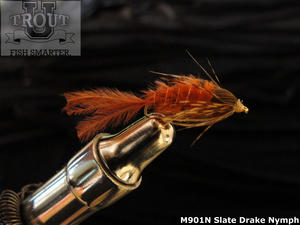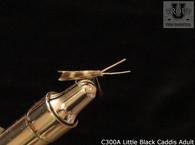
After mayfly eggs are laid, they hatch within usually 2 or 3 weeks and start the next cycle as nymphs. There are four basic types of mayfly nymphs - the burrowers, swimmers, clingers and crawlers. Each type has their own particular habitat and behavior. We have discussed the habitat and the behavior of the swimmer and crawler nymphs in the previous blogs. Now we will discuss the mayfly burrower nymphs.
The species of Ephemera mayflies are the big burrower nymphs including the Yellow Drakes, Eastern Green Drakes, Brown Drakes, Golden Drakes, Great Winged Olive Drakes, and other drakes as well. The mayfly burrowers are nocturnal creatures remaining burrowed in the sand and silt in the bottom of the streams.
These mayfly burrowers are most commonly found in the slow to moderately flowing water such as pools and backwaters that have silt or soft bottoms. The nymphs spend their lives buried and come out of their burrows to molt or to browse for food and finally to hatch. When fishing the bottom of these soft bottomed streams, watch for the mayfly nymphs swimming out of your way or hiding as you approach them and they usually are large enough to see.
The burrower nymph pattern is most effective when the nymphs are coming out of their burrows to hatch which is when they are most vulnerable to the trout. The burrower nymph is very clumsy and indeed a poor swimmer wobbling its tail and body in a manner that propels it from the bottom of the stream to hatch in the surface. When the nymphs are hatching, it will be necessary to add movement to your fly duplicating that wobbling motion that is made with their body and tail.
Present your fly from the bottom of the stream to the surface in as realistic of a manner as possible and use only the necessary amount of weight for the depth that you are fishing.
Their hatches have long been a favorite among anglers and on the Mossy Creek in Virginia are always excited to see the heavy hatches of the hexagenia limbata (Hex) Eastern Green Drake.
Learn more about mayflies and their life cycles in Class 301 "Introduction to Mayflies" and more about nymping can be found in Class 303 "Top Nymping Tactics". Both of these short free classes can be found in TroutProStore.com Graduate Level Classes. We will blog more about the other types of mayfly nymphs so stay tuned.





